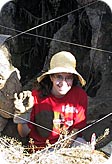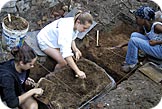| home | our mission | contact us | issue archive |

Jul 2001 / young minds :: email this story to a friend

History in a Hole
By Chip ClattoWhat would motivate high-school aged kids to spend their summer digging away in mud pits, starting as early as 7 a.m. and working well into the heat of a July day?
They're participants in the Lemp Avenue dig that hopes to unearth evidence of past use of the site as a stop on the Underground Railroad, the network used by many slaves to escape north to freedom in the 1800s. Although the dig has attracted many students and lots of media attention, there's still a lot of work to be done in getting the St. Louis Public Schools to recognize its potential as a living classroom for students from all over the metro area.
A few testimonials from the field:

"This is my second year on the site — I actually don't live in St. Louis anymore, because my family moved to California, but I wanted to come back this year. Last year, when I applied for the program, I had to go through an interview to find out why I wanted to do this, and they also asked questions like, 'Can you lift heavy buckets?' It's hard work, but when you find something, it makes it all worthwhile. I guess the most exciting things I've found so far are a skeleton key and part of a shoe with a wooden heel ... the kids in the privy are finding dolls, parts of dolls and bottles. As long as I keep on finding things, I'll keep digging!"
—Priscilla Pietz, age 16, home-schooled
"I was taking Mr. Clatto's American History class, and I participated in the mock dig on the hill behind Gateway, so I thought I might be interested in doing this program. Last year, I was in the spotlight because I found the elephant trunk. That was great, but there are so many days when you just dig and dig and don't find anything ... I have been digging deeper than they bury dead people! There have been times when I've begged Clatto for a new square."
—Jennie Zagarri, senior, Gateway Technical Institute

For the past two summers, students from Gateway Tech and other metro-area high schools have been participating in the excavation of 3314-3318 Lemp Avenue in south St. Louis. This site was chosen for excavation largely because of oral histories connecting the property to the Underground Railroad, but also for the information it can provide about mid-nineteenth century life in south St. Louis. Local oral history suggests that a tunnel entrance behind the house at 3314 Lemp leads to the Cherokee Cave, which until the 1960s opened onto the Mississippi River. From there, slaves could cross the river into Illinois, which was a free state.
Following two seasons of excavation, the site is open to several possible interpretations, which are not mutually exclusive. Slave quarters for the DeMenil estate may have been located on the property. German craftspeople, possibly associated with the nearby Lemp Brewery, may have been the earliest occupants. And, the site may have been part of the Underground Railroad. The excavations are exploring all these possibilities, and testing the following hypotheses:
- That the Lemp Avenue site was occupied prior to the Civil War;
- That there was an early African-American presence at the site
- That this site was a stop on the Underground Railroad via the tunnel leading to the Cherokee Cave
- That the site functioned as slave quarters for the DeMenil estate
- That there was an early German-American occupation of the site.
Evidence supporting the first hypothesis has already been recovered and includes maker's marks on ceramic and glass artifacts. The third hypothesis is supported by architectural and artifactual evidence.
The second hypothesis will be more difficult to test. Evidence directly supporting the presence of an Underground Railroad stop is likely to be particularly difficult to identify because of the nature of the Underground Railroad itself. The Underground Railroad functioned between the 1820s and the 1860s and consisted of loosely linked safe houses and abolitionists who would help guide African slaves out of slavery to free states and Canada. Because of the dangers of helping slaves gain their freedom, "stations" on the Underground Railroad were identified mostly by word of mouth.
Some aspects of the Underground Railroad make the Lemp Avenue site a good candidate for a stop. The presence of the tunnel and cave entrance provides a hidden means of transporting slaves to the Mississippi River. Cemeteries were sometimes used as landmarks in describing the location of Underground Railroad stops: a German Evangelical cemetery and a Baptist cemetery were located near the Lemp Avenue site. Oral traditions claim that this property was involved in the Underground Railroad.
It may not be possible to confirm or deny the site's use as a stop on the Underground Railroad. Excavations have already confirmed occupation prior to the Civil War and artifacts associated with Africans or African-Americans have been recovered. If further excavation uncovers evidence supporting Underground Railroad activity at the site, the Lemp Avenue site would be the first documented Underground Railroad stop in Missouri. If no evidence is found directly supporting the connection, a great deal could still be learned about the lives of early residents of south St. Louis.
Follow the progress of Chip and his team throughout their third season of excavation, and see many of the artifacts discovered thus far: http://www.stlcc.cc.mo.us/fv/users/mfuller/lempdig/Lemp.html
Chip Clatto teaches history and archaeology at the Gateway Institute of Technology.
Church and State | Games | Expatriates | Communities | From the Source
It's All Happening | Young Minds | The Ordinary Eye | Elsewhere
Sights and Sounds | Media Shoegaze | A Day's Work | From the Editor© 2001 The Commonspace
